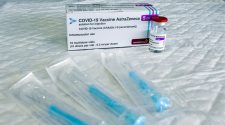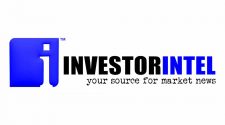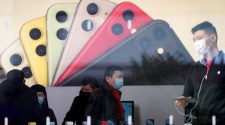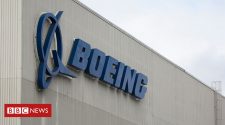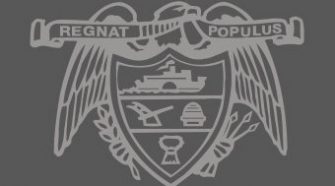Find all of the sessions from the FreightWaves Health & Pharma Supply Chain Summit below.
Following the XPO playbook key lesson in vaccine distribution
After months of delivering everything from personal protective equipment (PPE) to baby formula and military meals ready to eat (MRE) to frontline health care workers, XPO Logistics experts needed only to follow the company playbook when COVID-19 vaccine distribution began.
“We didn’t actually have to make any specific changes to our network,” Katrina Liddell, president of Global Forwarding and Expedite at the third-party logistics provider, told FreightWaves Executive Publisher Kevin Hill during the Health & Pharma Summit on Wednesday. “It was more about the best way to inject the product into the network.”
With pharmaceutical movement experience, XPO’s trailer visibility is critical.
“We can stay ahead of the trend of being able to have eyes on every truck, eyes in every trailer and be able to mitigate any situation that would harm or damage the product,” she said. “We know at all times if there is anything that changes that would affect the condition of the product.”
Trailer security is imperative. Driver teams tell no one other than the shipper and the contractor what they are hauling. Someone always stays with the trailer, which is preconditioned before a load of vaccines is moved.
“These are all industry best practices,” she said. “These are things that people in pharmaceutical practice on a regular basis. We’ve seen the whole industry come together to prioritize getting any kind of PPE, anything related to the vaccine, out as quickly and safely as possible.” –– Alan Adler
Advantages of using integrated solutions for health supply chains
In this session of the FreightWaves Health & Pharma Supply Chain Summit, Dooner and Michael “The Dude” Vincent host a live session of WHAT THE TRUCK?!? with Danny Loe, president of asset-light logistics and chief yield officer with ArcBest.
ArcBest has been instrumental in expediting health and pharmacy supply chains by using integrated solutions combined with ArcBest’s individual owned assets. Loe said every customer in the logistics world has different needs and requires different solutions to get freight moved in an effective manner.
ArcBest has worked with the Centers for Disease Control and Prevention since 2007, so it was well equipped to jump into action providing support as the pandemic accelerated. The company has “high-security, high-safety trailers,” says Loe which are essential when transporting valuable and delicate goods.
Loe said while ArcBest hasn’t directly handled any vaccine shipments, the company has handled vaccine support supplies and other necessities for health care supply chains. When it comes to possible virus surges, Loe said ArcBest is definitely better prepared than at the start of the pandemic. — Kaylee Nix
Diversification key to the medical supply chain
The pandemic has proven that diversification throughout the supply chain is the key to avoiding disruption. That was the insight provided by Todd Fagley, founder and CEO of MedSource Labs, during a virtual chat at the Health & Pharma Summit with FreightWaves’ John Kingston.
Fagley said his company did a great job responding to the medical crisis, shifting from a product lineup of devices to primarily becoming a frontline PPE provider. MedSource is a manufacturer of medical equipment and specializes in the development of infusion treatment products.
The company sources most production components from overseas markets. MedSource took a “war room” approach to procurement in the beginning of the pandemic, which included a significant increase in preplanning its transportation needs along with a bigger reliance on airfreight. The company was initially forced to move 90% of product through the air as it was getting a year’s worth of demand every month. Normally, MedSource is accustomed to moving 90% of its freight by ocean. The usage of airfreight still remains elevated as port congestion and a container shortage drag on.
The company had a diversified procurement strategy prior to COVID but plans to continue to expand its sourcing footprint to include more regions around the world and lessen its exposure to Southeast Asia. Fagley said these efforts have been “supercharged” following the outbreak. MedSource is also bringing on more supply chain staff as it looks to build out its distribution network. Fagley said near-shoring domestically remains difficult due to heightened regulation and that policy changes need to be adopted to make it more feasible. “It’s a great idea. We would love to do everything here to support our people here in our country but it’s a global world until we can really get that mindset set from a policy standpoint all the way through.” — Todd Maiden
Pharma distribution requires intense focus on supply chain visibility
Product exposure, contamination, theft – these are the concerns of every manager in the pharmaceutical and health care industry, which makes supply chain visibility in this sector that much more critical.
“When you’re moving from raw material suppliers through manufacturing and distribution to the end customer, you have to make sure that all the links in the supply chain are clean and that there are mitigation plans in place when required,” said Glenn Koepke, senior vice president of customer success at FourKites, which specializes in supply chain tracking.
Speaking during a fireside chat with FreightWaves Executive Publisher Kevin Hill during Wednesday’s Health & Pharma Summit, Koepke noted that the delicate nature of pharmaceuticals requires a more intense focus on visibility – importantly now as it applies to COVID-19 vaccine distribution. But products moving through the pharma and health care supply chain also include very fragile hospital equipment as well, which is why network planning is at the core of visibility in this industry, he said.
“For many sectors we do planning at the lane level, but in [pharma/health care] it’s on a lane and product level. So the idea of network command centers is very common within this segment because you have to have a set group of resources to allow you to diagnose where the errors are.”
If he had a crystal ball for major trends in this sector for the next three to five years, Koepke said he would bet on increased leveraging of artificial intelligence and machine learning, along with a less “archaic” approach to collaboration. “The question of whether a truck will arrive on time can take 20 calls or emails across a day or two, but it’s a question that should take less than 30 seconds to solve,” he said. “What we see with our customers right now is investing heavily in collaboration, which means I have one platform to talk to an end supplier, customer and carrier.” — John Gallagher



